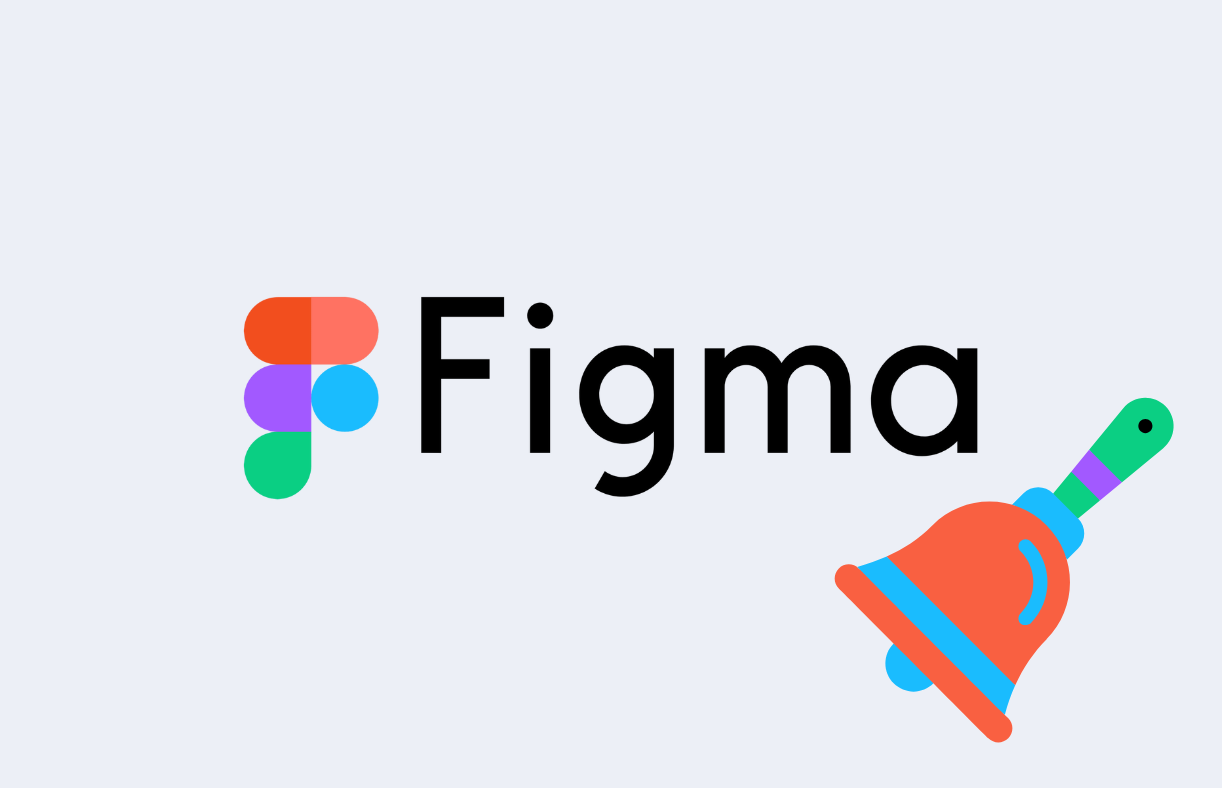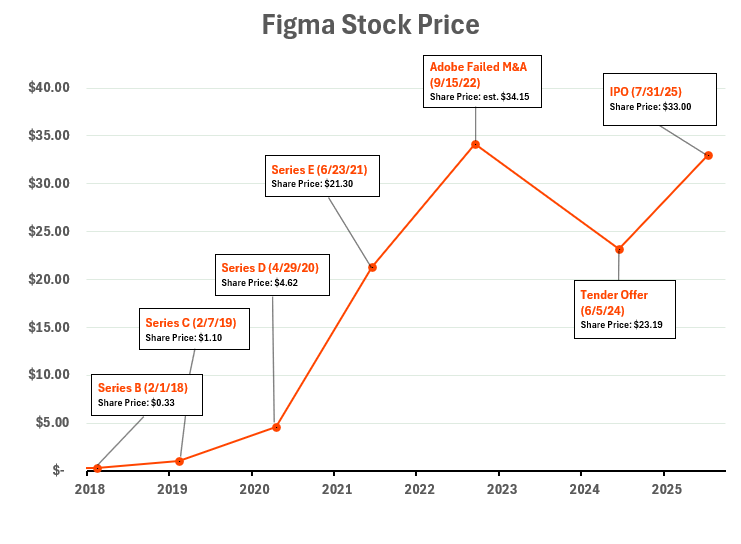Figma Prices IPO almost 3 Years After Failed Adobe Acquisition


Congratulations to Figma's investors and current/former employees on the upcoming IPO!
For those who don’t know, Figma is a collaborative cloud-based design platform for teams to create, prototype, and share interfaces in real time. It provides a robust set of vector graphics editing and prototyping tools, making it a central hub for designers, developers, and other stakeholders to work together on digital product design.
This is Figma’s second attempt at a liquidity event. In 2022, Adobe attempted to buy the company for $20B, but the acquisition failed due to anti-trust laws. Now, almost 3 years later, Figma is aiming for an $19.3B valuation in its upcoming IPO.
Let’s take a look at what investors and employees stand to make from this IPO. Please note that we will be using the initial IPO price for Figma at $33. Most employees/investors will have a 6-month lockup period, so their actual returns may vary depending on how the market views the company and how long they wait to sell.
Below is a graph of Figma’s stock price over time. We didn’t include any of the rounds before 2018 because the pricing was so low we can assume they all had great returns. We also estimated the failed M&A price by Adobe based on the $20B reported valuation. Lastly, for those unaware when looking at the graph, a tender offer is a formal offer by an investor (often a new or existing institutional investor) or the company itself to purchase shares directly from existing shareholders such as earlier investors or employees.

As you can see the Series B-D investors all did great. Ranging from an 99x to a 7x for the 2020 Series D, which handedly beats the S&P 500 which boast a 2.16x in that same time.
The Series E investors, which put money in during peak valuations, did not fare so well. They are getting about a 1.55x over 4 years, still beating the S&P which had a 1.49x return in that same time period.
Even though the deal never closed, it’s notable that Adobe’s offer remains higher than Figma’s IPO price nearly three years later.
Investors who participated in the most recent Tender offer achieved solid returns, beating the S&P 500 with a 1.42x return compared to the S&P's 1.18x. At the time, this was likely seen as a safe bet, especially since it was priced at a discount to the failed Adobe M&A.
Unfortunately, Figma's S-1 only contained one exercise price for employees, and that was the $23.19 Tender price, which we’ve already analyzed. We do know however that in 2022 the average price of exercised shares was $0.19. We don’t know when or how many employees were given this price, but that would net a return of almost 174x, not too shabby at all.
In 2024 this average price of exercise jumped to $10.18. This is still a very respectable return of a 3.24x.
It’s probably a fair assumption to say that the majority of employees who exercised and held onto their equity at Figma have received a very nice return on their stock options.
One thing to consider here is that many employees likely sold during the 2024 Tender Offer. After almost being acquired by Adobe for $20B in September 2022, employees likely got excited about the prospects of a great exit. The acquisition then underwent heavy regulatory scrutiny, due to antitrust concerns, that lasted until December 2023, when the two companies mutually agreed to call off the deal.
Ultimately, for employees, this highly anticipated exit never materialized, likely leaving many with a sense of missing out. Fast forward about 6 months, and Figma offered its employees a Tender Price of $23.19, which we estimate to be about two thirds of the price they would have received from Adobe (confirmed by news stories showing the tender was priced at $12.5B).
This tender offer, according to the company, was sized above $600M, meaning many employees cashed in during this opportunity. Overall, they still had great outcomes, but pending Figma’s price movement over the upcoming 6 month lockup, they may have left some money on the table.
This does highlight a potential downside of selling pre-IPO, but you can’t always guarantee that pre-IPO secondary or tender buyers will make money and there is value in taking the bird in hand when presented an opportunity to sell. This situation is particularly interesting however, given order of events for Figma employees: Adobe pump fake at $20B → Tender Offer at $12.5B → IPO at $19.3B.
At the end of the day, employees came out great whether they sold in the Tender or waited for the IPO.
Update as of 7.31.2025: Figma's first day of trading closed at an incredible $115.50. This is over three times the initial IPO price. Will be fun to see what the final price is in 6 months after the lockup is over.
Written by Sam Stroud, Investor at ESO Fund
Regulators in the U.S., UK, and EU raised antitrust concerns, and in December 2023, Adobe and Figma mutually agreed to cancel the deal.
Yes. Depending on when they exercised and if they sold during the 2024 Tender, employees are on track to make great money from the IPO.
NOTE: there is still a 6 month IPo-lockup period. Employees must wait this out before they can sell.
At the time, yes. It offered liquidity during uncertaint. But with the IPO priced higher, some who sold may feel they missed out on upside.
Yes, ESO Fund does offer IPO Lockup Loans to cover the cost of exercise during your lockup period.
An IPO allows you to sell your shares on the public markets, but lock-up periods may prevent selling immediately after the offering.
Equity decisions are complex, but you don’t have to navigate them alone. ESO Fund has been helping employees unlock the value of their hard-earned equity for over a decade. Whether you’re exercising, planning for taxes, or looking for liquidity, we’re here to provide clear, non-recourse funding solutions tailored to your situation.
📘 Overview of How We Work
See our 3-step process.
⏰ Option Exercise Funding
Exercise without risking savings.
⭐ Client Reviews
Hear from employees we’ve helped succeed.
🚀 Share Liquidity
Unlock cash while keeping your shares.
📊 AMT Calculator
Estimate tax exposure in minutes.
🤝 RSU Liquidity
Access liquidity from vested RSUs before IPO.
Ready to explore your equity options? Our team is here to walk you through the next steps.
Schedule a Call
This innovative service promotes and enables a healthier relationship between companies and employees. I my opinion it's valuable to employees and great for the overall tech environment and economy. It is good for nobody when employees feel trapped because they can't afford to leave. In less extreme cases exercising can be expensive and somewhat risky and this is simply a good smart hedge and a good square deal. Brilliant!
